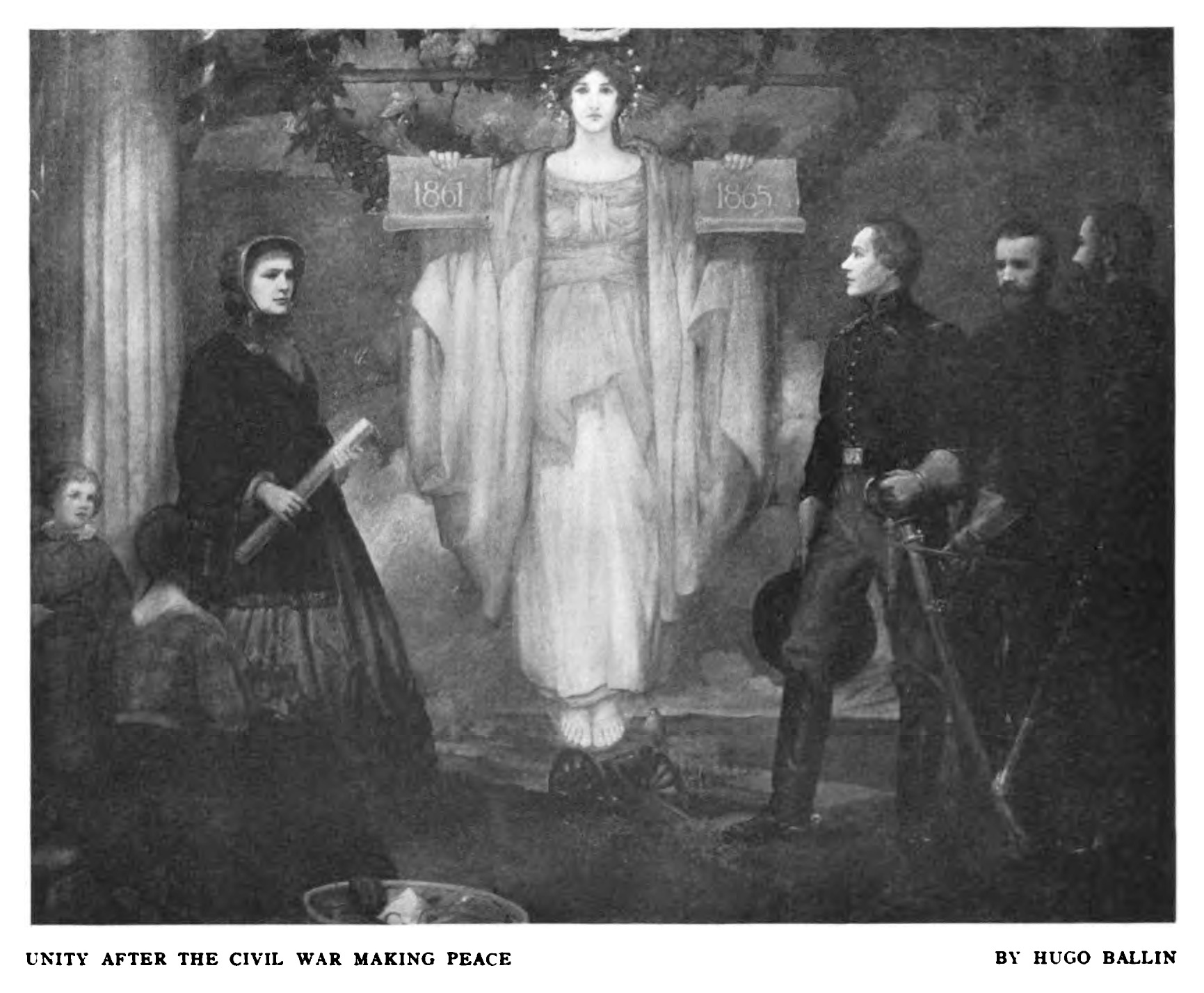Executive Chamber - Unity After the Civil War Making Peace

- In Ballin's Words
- Allegory and History
- Source/Citations
Ballin described his murals in a pamphlet published in 1913:
"Lieutenant Alonzo Cushing, General Edward S. Bragg, General J.C. Starkweather and Mrs. Cordelia A. P. Harvey, surrounding a symbolic figure representing Unity, the spirit of the Civil War.
"Lieutenant Alonzo Cushing, General Edward S. Bragg, General J.C. Starkweather and Mrs. Cordelia A. P. Harvey, surrounding a symbolic figure representing Unity, the spirit of the Civil War.
The standing figure, with hat in hand, is Lieutenant Alonzo Cushing, who entered West Point in 1857, in the seventeenth year of his age, and was graduated June 24th, 1861. Cushing distinguished himself at Gettysburg by repulsing Pickett's charge, and during his action was mortally wounded.
The figure to the right of Cushing is General Edward S. Bragg, born February 20th, 1827, died 1912. In 1861, upon the occasion of the first war-meeting in Fond du Lac, when many of his political friends were lukewarm and hesitating, he made a speech which is pronounced as the first great effort of his life. Bragg raised a company for the Sixth Wisconsin. He was finally commissioned a brigadier general by the President. He commanded the famous iron brigade.
The figure in the three-quarter back is General J.C. Starkweather, colonel of the first regiment to leave Wisconsin for the Civil War. The troops remained in camp until June 9th, 1861, when, in obedience to orders from Washington, the first regiment left the state for Harrisburg, PA.
Mrs. Cordelia A. P. Harvey was the wife of Louis P. Harvey, of Wisconsin, who went south soon after the battle of Shiloh to furnish Wisconsin soldiers with army supplies and medical aid. Governor Harvey was drowned in passing from one boat to another at Savannah. Mrs. Harvey for a time succumbed to her deep grief, but realizing the importance of her husband's mission, she was convinced that her duty lay in finishing the work Mr. Harvey had so nobly commenced. She became a sanitary agent. She obtained a grant from President Lincoln to establish a general hospital, located in Madison, known as the Harvey hospital. In 1865, she interested herself in establishing a soldiers' orphans home, of which she was the first superintendent. The boy behind her represents an orphan - the growing generation. The young girl in the foreground stands for home influences and interests which were potent factors during the civil war."
Ballin's painting on the South wall of the Executive Chamber, "Unity After the Civil War Making Peace," captures the fusion of allegory and history in his murals in the Wisconsin State Capitol. Like his paintings on the ceiling, the spirit of Unity is embodied in a beautiful, virginal female, wearing a crown with a halo hovering above her head to accentuate her angelic quality. But here he adds a series of real historical characters from Wisconsin’s history like those in the other portraits on the walls, including several who fought and died during battles - Mrs. Cordelia A. P. Harvey, who convinced President Lincoln to support her opening a veteran's hospital in Wisconsin during the war, and General John Starkweather, colonel of Wisconsin's First Volunteer Infantry who was later commissioned as brigadier general for all U.S. volunteers. Ballin places the figures in a pastoral setting much like that of his allegorical works on the ceiling, but with a cannon visible and a battle scene off in the distance. More than any of the other murals he painted in Wisconsin, “Unity” captures Ballin’s desire to balance his classical education with the trend towards more modern, realistic mural painting emerging among his peers.
Several months after Ballin completed the murals, the commissioners decided to withhold their final payment because, the paintings were “not entirely satisfactory.” The daughter of one of the historical characters portrayed in the murals, General Starkweather, had appeared at one of their meetings and criticized the likeness of her father. Ballin had based the painting on historic details provided by General Charles King of Milwaukee, a Civil War veteran who published several books on the topic, but some questioned his accounts. A local veterans’ organization provided solid information to refute the account, and the commission reported to Ballin that, “with reference to General Starkweather, the facts were very different from what we had been led to suppose.” Ballin returned to Madison and redid portions of the “Unity” painting, most significantly, reducing the size of the allegorical female figure so that she was closer in scale to the historical figures. He did not, however, change the Starkweather portrait suggesting he was open to the idea of recalibrating his balance between allegory and history but dismissed their challenges to the accuracy of his version of Wisconsin’s history. Ballin exhibited that particular and prickly disposition throughout the rest of his career, but managed to avoid similar conflicts with his patrons.
Image appears in The International Studio vol. 51, no. 204 (Feb., 1914), p. 375.
Ballin's quotation appears in his pamphlet, "Mural Paintings in the Executive Chamber, State Capitol Building Madison, Wisconsin," (New York: 1913).
Details on the conflict and text of the commissioner's letters appear in “Historic Structure Report” issued by the State of Wisconsin’s Department of Administration, Division of Facilities Development in 2004.
| Previous page on path | Wisconsin State Capitol - Gallery, page 8 of 8 | Path end, return home |

Discussion of "Executive Chamber - Unity After the Civil War Making Peace"
Add your voice to this discussion.
Checking your signed in status ...